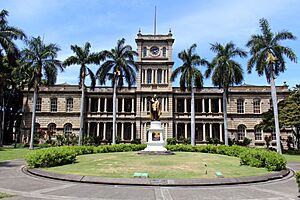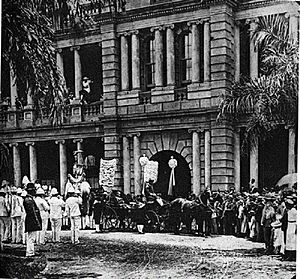1892 Legislative Session of the Hawaiian Kingdom facts for kids
The 1892 Session of the Legislature of the Hawaiian Kingdom, also known as the Longest Legislature, was a very important meeting of the Hawaiian Kingdom's government. It lasted from May 28, 1892, to January 14, 1893. This was the first time the legislature met during the reign of Queen Liliʻuokalani. It was also the last time the legislative assembly met while Hawaii was still a monarchy.
Just three days after this long meeting ended, big political problems and the queen's attempt to create a new constitution led to the overthrow of the Hawaiian Kingdom on January 17, 1893. This event changed Hawaii's history forever.
The people who were part of this legislature came from different backgrounds. They included Native Hawaiians, people of European and American descent, and even some of Asian descent. They were divided into different political groups. Some of these people later helped to remove the queen from power. Others became leaders who tried to stop the overthrow and prevent Hawaii from becoming part of the United States.
Contents
How the Legislature Began
In 1887, King Kalākaua was forced to sign a new set of rules called the Bayonet Constitution. This happened because a group of foreign businessmen and Hawaiian subjects, like Lorrin A. Thurston, pressured him. This new constitution greatly limited the king's power. It also made the king's cabinet, or group of advisors, much stronger.
The Bayonet Constitution also made it harder for many poor Native Hawaiians and Asian citizens to vote. At the same time, it gave voting rights to foreign residents from Europe or America who were not even citizens. It also changed how the House of Nobles, the upper part of the legislature, worked. Before, the king chose these members for life. Now, they had to be elected.
The people who forced the king to sign this constitution formed a group called the Reform Party. They won most of the seats in the 1887 election. But in the 1890 election, other groups like the Hui Kālaiʻāina joined together to form the National Reform Party. This new party was against the Reform Party. The Reform Party lost its power in the legislature, and their cabinet was removed.
After the 1890 legislature finished its work, King Kalākaua passed away in San Francisco. His sister, Queen Liliʻuokalani, became the new ruler on January 29, 1891.
The 1892 Election
The election in 1892 was very competitive. There were four main political groups: the Reform Party, National Reform Party, National Liberal Party, and the Native Sons of Hawaii. The National Reform Party became the queen's main supporters. They worked with the Reformers and Native Sons against the National Liberal Party.
The National Liberal Party wanted more Native Hawaiians to be involved in the government. They also wanted a new constitution to replace the unpopular Bayonet Constitution. However, the Liberals themselves were divided. Some, like Joseph Nāwahī and William Pūnohu White, were loyal to the queen. Others, like John E. Bush and Robert William Wilcox, wanted bigger changes, like more power for the people or even a republican government.
The election results showed a divided legislature. It was hard to know exactly which party many elected members truly supported. Historians say that out of the 48 elected members, about 23 were from the Reform Party, 13 from the Liberal Party, 9 from the National Reform Party, and 3 were independent.
The Long Legislative Session

From May 28, 1892, to January 14, 1893, the Hawaiian legislature met for an amazing 171 days. This is why it's called the "Longest Legislature." This was the first session under Queen Liliʻuokalani and the last one during the Hawaiian monarchy.
When the session began, 48 elected politicians gathered at Aliʻiōlani Hale in Honolulu. This building was across the street from ʻIolani Palace. The legislature had two parts: the House of Nobles and the House of Representatives. Noble John Smith Walker was the President, and Noble John Kauhane was the Vice-President.
The members came from many backgrounds. They included Native Hawaiians, people of mixed Hawaiian and European descent, and even three members of Chinese-Hawaiian descent. The queen's appointed cabinet ministers could also join the meetings and vote on most issues. During the session, some members resigned, and new ones were chosen in special elections.
This session was full of arguments and disagreements between the different political groups. They debated important issues like the demand for a new constitution. They also discussed bills about a lottery and licensing opium. These bills were meant to help the economy, which was struggling because of the McKinley Tariff. By the end of the session, the queen signed both the lottery and opium licensing bills into law. These laws were very controversial, especially among the foreign community and the Reform Party leaders.
Many legislators, including Noble David William Pua and Representatives Joseph Nāwahī and William Pūnohu White, asked for a new constitution. Both the National Liberals and National Reformers had promised a new constitution during their election campaigns. However, some National Reformers wanted to make changes through amendments instead of a completely new constitution. The conservative Reformers did not want any changes at all. There was also disagreement about how to legally change the constitution.
A major problem between the queen and the legislators was her cabinet ministers. The 1887 constitution allowed the queen to choose her ministers. However, it also gave the legislature the power to remove them with a vote. During this session, the legislature voted to remove four of the queen's cabinets.
During this time, Representative Nāwahī also suggested a bill to give women the right to vote. This bill did not pass. If it had, Hawaii would have been the first nation to allow women to vote, even before New Zealand.
On January 13, 1893, the legislature removed the Wilcox cabinet. This cabinet had ties to the Reform Party. The queen then appointed a new cabinet, known as the Parker cabinet. This cabinet was connected to the National Reform Party. Its members included Samuel Parker for foreign affairs, John F. Colburn for the interior, William H. Cornwell for finance, and Arthur P. Peterson as attorney general.
The legislative session officially ended on January 14, 1893. The queen led a ceremony at Aliʻiōlani Hale, which was right across from ʻIolani Palace.
What Happened Next
After the legislature finished, Queen Liliʻuokalani tried to create a new constitution. She wanted to do this while the legislature was not meeting. She secretly worked with two Liberal Party leaders, Nāwahī and White, and her Royal Guards captain, Samuel Nowlein, to write it.
On the afternoon of January 14, the queen met with her cabinet ministers. At the same time, members of the Hui Kālaiʻāina and other Native Hawaiian leaders marched to ʻIolani Palace. They had a sealed package with the new constitution for the queen to announce. However, the queen found that her ministers did not want to sign the new constitution. She had to put her plans on hold and send the political leaders and crowds away from the palace. She later wrote that her advisors had led her "out to the edge of a precipice" and then left her alone.
The queen's actions caused a lot of political upset in Honolulu. People who were against the monarchy and wanted Hawaii to join the United States formed the Committee of Safety. They were upset about the queen's "revolutionary" actions and planned to remove her from power. This group included legislators like Lorrin A. Thurston.
In response, people who supported the queen formed the Committee of Law and Order. They met at the palace square on January 16. Leaders like White, Nāwahī, Bush, and Wilcox gave speeches supporting the queen and the government.
These events and the tense political situation led to the overthrow of the monarchy on January 17, 1893. The Committee of Safety, with secret help from the United States Minister John L. Stevens and American forces from the USS Boston, took over. After a short time under a temporary government, the Republic of Hawaii was formed on July 4, 1894. Sanford B. Dole became its president. This new government was mostly run by people of American and European descent. However, a few Native Hawaiians from the 1892 legislature, like John Ena and John Kauhane, were involved in the Republic's government.
Many former legislators from the 1892 session, including Robert William Wilcox and Joseph Nāwahī, led the fight against the overthrow and tried to stop Hawaii from becoming part of the United States. In 1893, Nāwahī and others formed the Hui Aloha ʻĀina (Hawaiian Patriotic League) to protest annexation. In 1895, Wilcox led an unsuccessful attempt to restore the monarchy.


